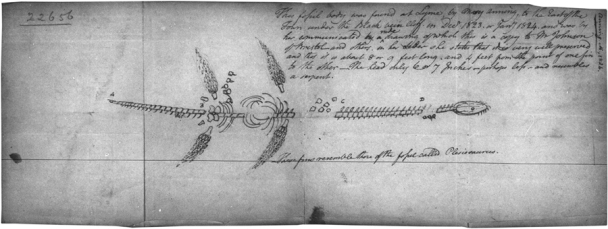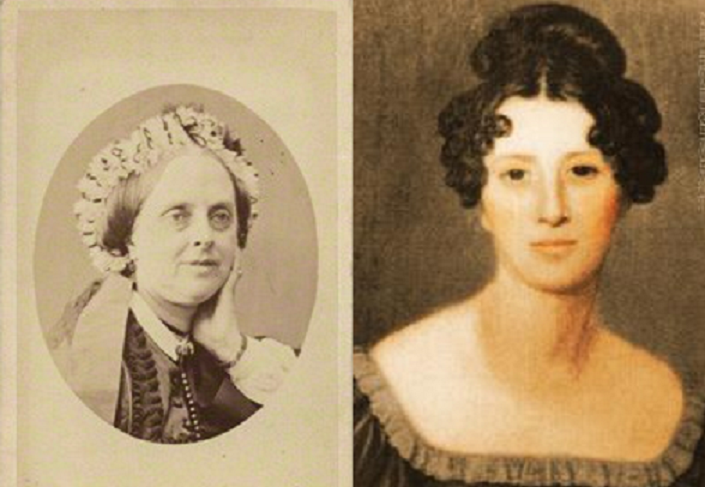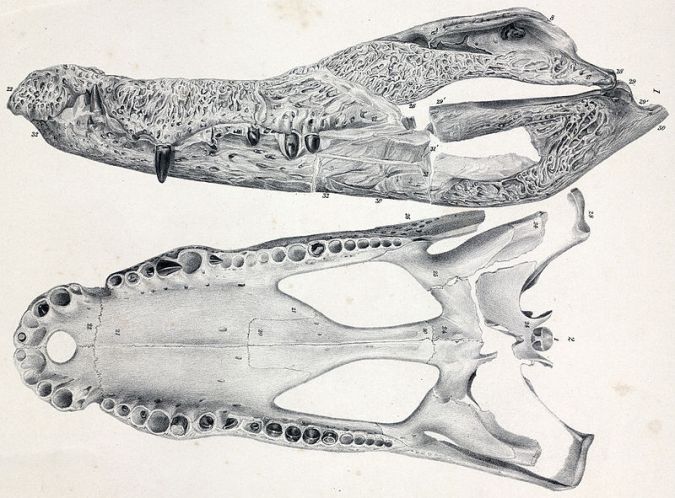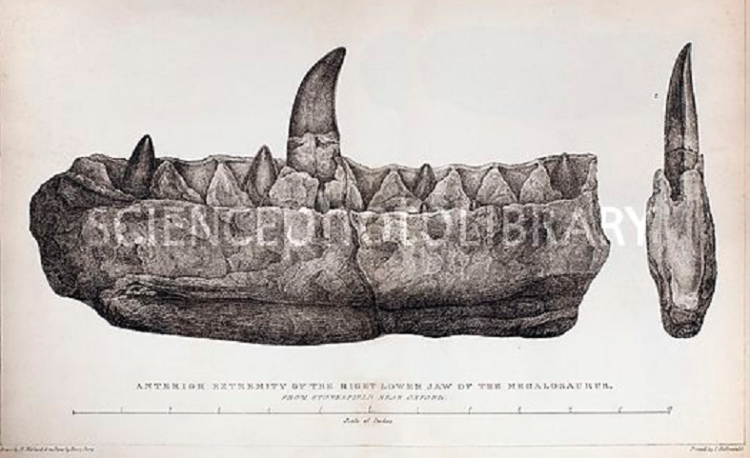
A sketch of a Plesiosaur by Mary Anning, 1824. From original manuscripts held at the Natural History Museum, London. © The Natural History Museum, London
The nineteen century was the “golden age” of Geology. The Industrial Revolution ushered a period of canal digging and major quarrying operations for building stone. These activities exposed sedimentary strata and fossils. So, the concept of an ancient Earth became part of the public understanding and Literature influenced the pervasiveness of geological thinking. The study of the Earth became central to the economic and cultural life of the nation and in 1807, the Geological Society of London is founded with the purpose of making that geologists become familiar with each other, adopting one nomenclature and facilitating the communications of new facts.
The most popular aspect of geology was the collecting of fossils and minerals and the nineteenth-century geology, often perceived as the sport of gentlemen,was in fact, “reliant on all classes” (Buckland, 2013). Women were free to take part in collecting fossils and mineral specimens, and they were allowed to attend lectures but they were barred from membership in scientific societies. It was common for male scientists to have women assistants, but most of them went unacknowledged and become lost to history (Davis, 2009). However, some women found the way to cross that line and make a name in Geology.

Mary Elizabeth (née Horner) Lyell, (1808–1873), wife of Sir Charles Lyell, by Horatio Nelson King © National Portrait Gallery, London, and Mary Ann (née Woodhouse) Mantell (1795–1869), wife of Dr. Gideon Mantell, © 2014 The Natural History Museum, London.
The early female scientists belonged to wealthy families or they benefited from their associations. In the first group we could find Etheldred Benett of Wilshire (1776–1845), she described the stratigraphic and geographic distribution of fossils of Wiltshire. Although she was not formally published, Benett wrote several manuscripts, which are now in the collections of the Geological Society of London.
Barbara Rawdon (née Yelverton) Hastings (1810–1858), 20th Baroness Grey de Ruthyn and Marchioness of Hastings was known as a fossil collector and a “lady-geologist” . She is also well known for the “Hastings Collection,” consisting of several thousand fossil specimens from England and Europe. She also studied the stratigraphy of England and published her findings in “Description géologique des falaises d’Hordle, et sur la côte de Hampshire, en Angleterre” (Hastings, 1851–52) and “On the tertiary beds of Hordwell, Hampshire” (Hastings, 1853).
The Philpot sisters (Margaret, ?–1845; Mary, 1773?–1838; Elizabeth, 1780–1857) were also well know for their fossil collection and their friendship with Mary Anning. They lived in Lymes Regis and amassed an important collection of fossils from the Jurassic. Elizabeth maintained correspondences with William Buckland, William Conybeare, Henry De la Beche, Richard Owen, James Sowery and Louis Agassiz.

Skull of Crocodilus hastingsiae named by Sir Richard Owen, in honor to Barbara Hastings. Image from Wikimedia Commons.
In the other group we could find those women who worked with their husbands. The most prominent of these women were Mary (née Moreland) Buckland (1797–1857), wife of Rev. William Buckland; Mary Ann (née Woodhouse) Mantell (1795–1869), wife of Dr. Gideon Mantell; Charlotte (née Hugonin) Murchison (1789–1869) wife of Sir Roderick Murchison; and Mary Elizabeth (née Horner) Lyell (1808–1873), wife of Sir Charles Lyell (Davis, 2009).
Mary Morland (1797–1857) illustrated some of George Cuvier’s work before she became Mrs William Buckland. She made models of fossils for the Oxford museum and repaired broken fossils. She assisted her husband by taking notes of his observations and illustrating his work. After the death of her husband, she continued working on marine zoophytes.
Charlotte Murchinson (1789–1869) was a strong influence for her husband and introduced him in the world of geology. She accompanied him on excursions and spent time sketching the landscape and outcrops and collecting Jurassic fossil specimens from the beaches.
Mary Mantell (1795–1869) discovered the teeth of Iguanodon, which led to her husband’s publication of an important paper announcing the discovery of a new giant reptile (Creese and Creese, 1994). She also made the illustration of Mantell’s work: “Fossils of the South Downs: or Illustrations of the Geology of Sussex”. Mary Mantell left her husband in 1839 and the children remained with their father as was customary.
Mary Lyell (1808–1873) was daughter of the geologist Leonard Horner. She read both French and German fluently and translated scientific papers for her husband and managed his correspondence. She later specialized in conchology and regularly attended meetings of the London Geological Society.
Mary Anning (1799-1847), was an special case. Despite her lower social condition and the fact that she was single, Mary became the most famous woman paleontologist of her time. She found the first specimens of what would later be recognized as Ichthyosaurus, the first complete Plesiosaurus, the first pterosaur skeleton outside Germany and suggested that the “Bezoar stones” were fossilized feces.
Fighting in their own way against the difficulties, women had contributed significantly to the development of geology and paleontology. Fortunately, geoscientists and historians are rescuing these woman from oblivion.
References:
BUREK, C. V. & HIGGS, B. (eds) The Role of Women in the History of Geology. Geological Society, London, Special Publications, 281, 1–8. DOI: 10.1144/SP281.1.
Davis, Larry E. (2009) “Mary Anning of Lyme Regis: 19th Century Pioneer in British Palaeontology,” Headwaters: The Faculty Journal of the College of Saint Benedict and Saint John’s University: Vol. 26, 96-126.
Buckland, Adelene: Novel Science : Fiction and the Invention of Nineteenth-Century Geology, University of Chicago Press, 2013.

Some fascinating info here! You and your readers might also enjoy my article on Maria Graham’s involvement in a big geological controversy of the 1830s, available in the Journal of Victorian Culture – details below!
Carl Thompson, ‘Earthquakes and Petticoats: Maria Graham, Geology, and Early Nineteenth-Century “Polite” Science’. Journal of Victorian Studies, 2012, 17.3, 1-18
Pingback: Mary Anning’s contribution to French paleontology. | Letters from Gondwana.
Pingback: Mary Somerville, Queen of Science. | Letters from Gondwana.
Yes, very good! And check out Turner, Burek & Moody on Women in a (Saurian) man’s world in the 2010. History of dinosaurs volume from Geol. Soc, London
Pingback: Mignon Talbot and the forgotten women of Paleontology. | Letters from Gondwana.
Pingback: Whewell’s Gazette: Vol. #18 | Whewell's Ghost
Pingback: Dorothea Bate: cave explorer and paleontologist. | Letters from Gondwana.
Pingback: Whewell’s Gazette: Year 2, Vol. #34 | Whewell's Ghost
Pingback: Whewell’s Gazette: Year2, Vol. #35 | Whewell's Ghost
Pingback: Mary Anning and the flying dragon. | Letters from Gondwana.
I was recently fortunate enough to see one of William Smith’s original maps on display at the Museum in Peterborough. It was stunning. A spur of the moment decision to pop into the exhibition while I was delivering some flyers and leaflets about forthcoming events I’d organised.
I did my degree in Geology and Planetary Science because I was writing a science fiction novel which had a geological setting and a geologist hero – you can see the results on my site, where I’m serialising the novel a few chapters at a time at present.
Pingback: A brief history of Pterosaurs. | Letters from Gondwana.
Pingback: Forgotten women of Paleontology: The Newnham quartet. | Letters from Gondwana.
Pingback: Mary Anning and the Hunt of Primeval Monsters. | Letters from Gondwana.
Pingback: Mary Anning, ‘the greatest fossilist the world ever knew’. | Letters from Gondwana.
Pingback: On the bicentenary of Mary Anning’s Plesiosaurus. | Letters from Gondwana.